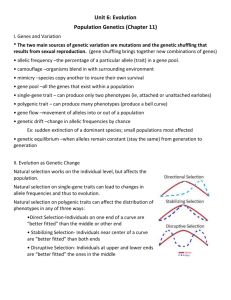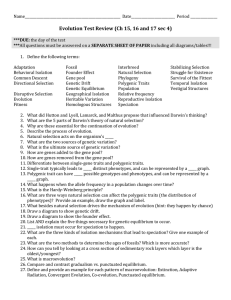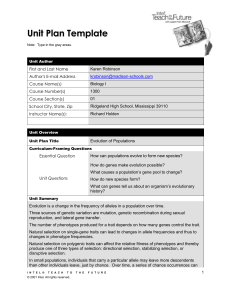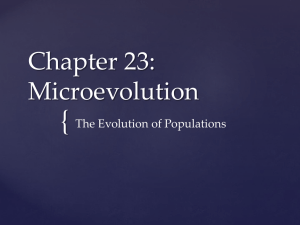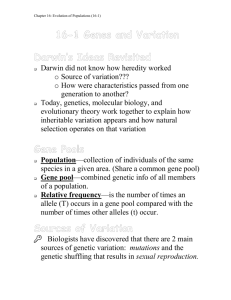Evolution of Populations Worksheet
advertisement
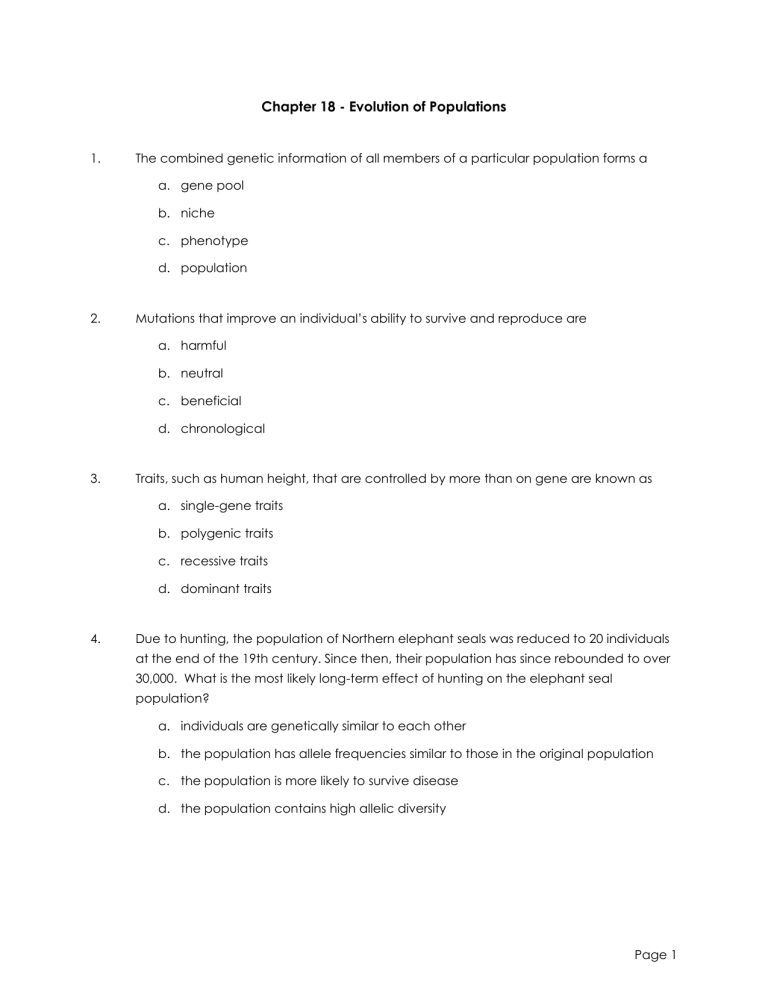
Chapter 18 - Evolution of Populations 1. The combined genetic information of all members of a particular population forms a a. gene pool b. niche c. phenotype d. population 2. Mutations that improve an individual’s ability to survive and reproduce are a. harmful b. neutral c. beneficial d. chronological 3. Traits, such as human height, that are controlled by more than on gene are known as a. single-gene traits b. polygenic traits c. recessive traits d. dominant traits 4. Due to hunting, the population of Northern elephant seals was reduced to 20 individuals at the end of the 19th century. Since then, their population has since rebounded to over 30,000. What is the most likely long-term effect of hunting on the elephant seal population? a. individuals are genetically similar to each other b. the population has allele frequencies similar to those in the original population c. the population is more likely to survive disease d. the population contains high allelic diversity Page 1 5. A small group of squirrels gets separated from the rest of the population due to a large flood. These squirrels, now confined to this new island, begin to start a new population. This is an example of which of the following? a. genetic drift b. bottleneck effect c. sympatric speciation d. founder effect 6. A population of birds live on an island where seeds are their primary food source. Birds with smaller beaks can eat small seeds more easily and birds with larger beaks can eat large seeds more easily. A fungus destroys the plants that make large seeds, leaving only the small seeds as food. Which type of natural selection will most likely occur? a. directional stabilization b. stabilizing selection c. disruptive selection d. artificial selection 7. In humans, babies that are born too small often lack the reserves to thrive, and babies that are too large are prone to difficult births. Since babies at the extremes are less likely to survive, evolutionary pressures favor moderately-sized babies. What type of selection is this an example of? a. stabilizing selection b. disruptive selection c. artificial selection d. directional selection 8. What mechanism of evolution occurs when allele frequencies change over generations due to random chance? a. gene flow b. natural selection c. mutation d. genetic drift Page 2 9. In corn, purple kernels are dominant to yellow. A random sample of 100 kernels is taken from a population in Hardy-Weinberg equilibrium. It is found that 9 kernels are yellow and 91 kernels are purple. What is the frequency of the yellow allele in this population? a. 0.09 b. 0.3 c. 0.49 d. 0.7 10. What is true of populations that are in Hardy-Weinberg equilibrium? a. natural selection is occurring b. the populations must be very small c. mating is random d. organisms are constantly migrating 11. Temporal isolation occurs when two different populations a. develop different mating behaviors b. become geographically separated c. reproduce at different times d. interbreed 12. When two populations no longer interbreed, what is the result? a. genetic equilibrium b. reproductive isolation c. stabilizing selection d. artificial selection 13. A group of regulatory genes that determine which parts of an embryo develop into arms, legs, or wings are known as a. polygenic genes b. molecular clocks c. neutral genes d. Hox genes Page 3 14. Each “tick” of molecular clock is an occurrence of a. genetic drift b. crossing-over c. DNA mutation d. mitosis 15. Natural selection acts directly on a. alleles b. genes c. phenotypes d. mutations 16. In a fox population, the allele frequency of a gene for red fur changes from20 to 30 percent. What can you say about that population of foxes? a. the population is expanding b. the population is evolving c. the population is decreasing d. the population is not evolving 17. A change in the genetic material of a cell is called a a. recombination b. polygenic trait c. single gene trait d. mutation 18. In organisms that reproduce sexually, most variation that can be inherited is due to a. mutations during gamete formation b. polygenic traits c. gene recombination during sexual reproduction d. the effects of radiation Page 4 19. A single gene trait that has two alleles and that show as a simple dominant-recessive pattern will result in a. one phenotype b. two phenotypes c. four phenotypes d. millions of phenotypes 20. The frequency of phenotypes for a typical polygenic trait is most often illustrated as a a. scatter plot b. bell-shaped curve c. pie chart d. histogram 21. Label the three types of selection illustrated by the graphs below 22. If a mutation introduces new skin color in a lizard population, which factor might determine whether the frequency of the new allele will increase> a. how many other alleles are present b. whether the mutation makes some lizards more fit for their environment than other lizards c. how many phenotypes the population has d. whether the mutation was caused by nature or by human intervention Page 5 23. Which of the following events do biologists consider a random change? a. directional selection b. speciation c. disruptive selection d. genetic drift 24. The type of genetic drift that follows the colonization of a new habitat by a small group of individuals is called a. the Hardy-Weinberg principle b. the founder effect c. directional selection d. stabilizing selection 25. The situation in which allele frequencies in the gene pool of a population remain constant is called a. evolution b. genetic drift c. genetic equilibrium d. natural selection 26. The separation of populations by barriers such as rivers, mountains or bodies of water is called a. temporal isolation b. geographic isolation c. behavioral isolation d. genetic equilibrium 27. The definition of a species is: a. similar types of animals from similar types of environments b. similar types of animals that can interbreed c. animals with similar genes and DNA d. animals that can interbreed and produce fertile offspring Page 6 28. Which of the following statements defines the members of a species? a. they are temporarily isolated from each other b. they are geographically isolated from each other c. they mate and produce offspring d. the have identical genes 29. The geographic isolation of two populations of a species tends to increase differences between their gene pools because it a. prevents interbreeding between the populations b. prevents interbreeding within each population c. causes temporal isolation of the two populations d. increase differences in courtship behavior 30. Although they often live in the same habitat, the American toad breeds earlier in the spring than the Fowler’s toad does. What can be inferred from this information? a. the two species do not interbreed because of geographic isolation b. the two species do not interbreed because of temporal isolation c. the two species interbreed throughout the spring season d. the American toad will cause the extinction of the Fowler’s toad 31. Species Y and Z have very similar proteins, genes and genetic sequences. What is most likely true about these two species? a. species Y is older than species Z b. species Y is younger than species Z c. species Y evolved for a long tie separately from species Z d. species Y shares a relatively recent common ancestor with species Z 32. A large number of manatees is killed off due to a major hurricane event in the state of Florida. What type of effect may occur within the population relating to its gene pool? a. a founder effect b. a speciation effect c. a genetic equilibrium effect d. a bottleneck effect Page 7
